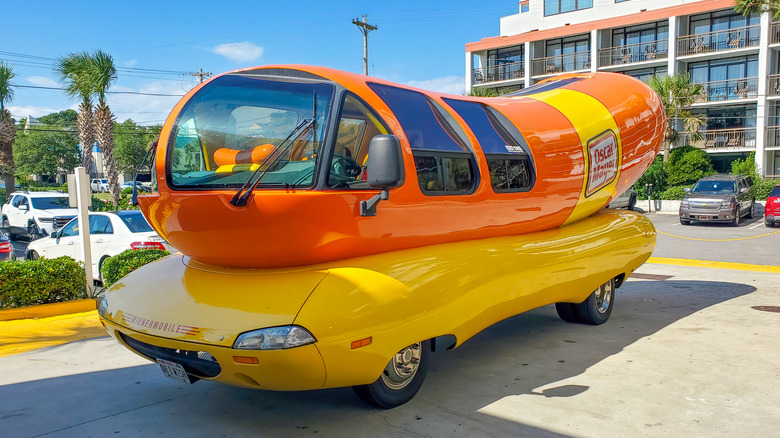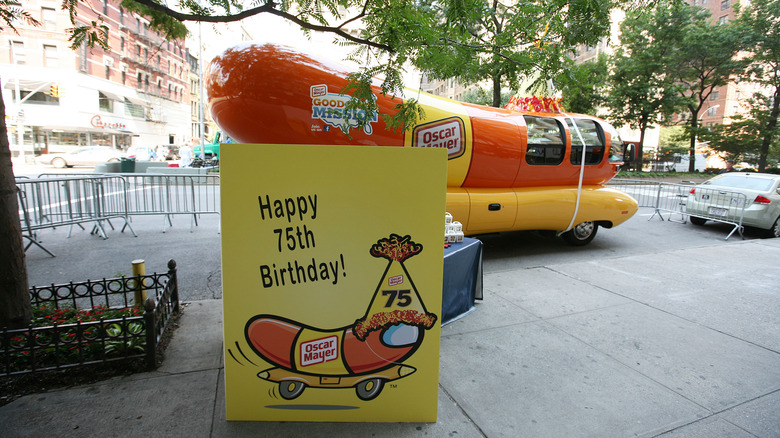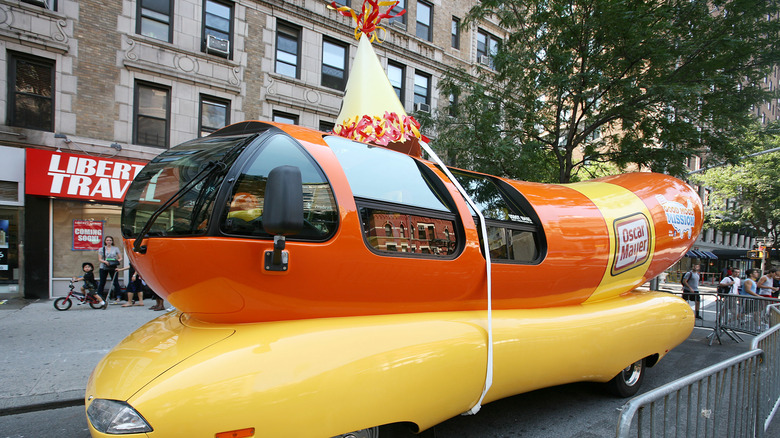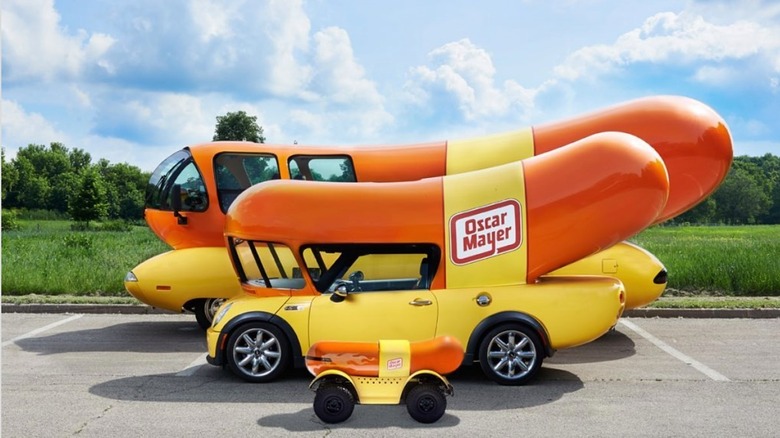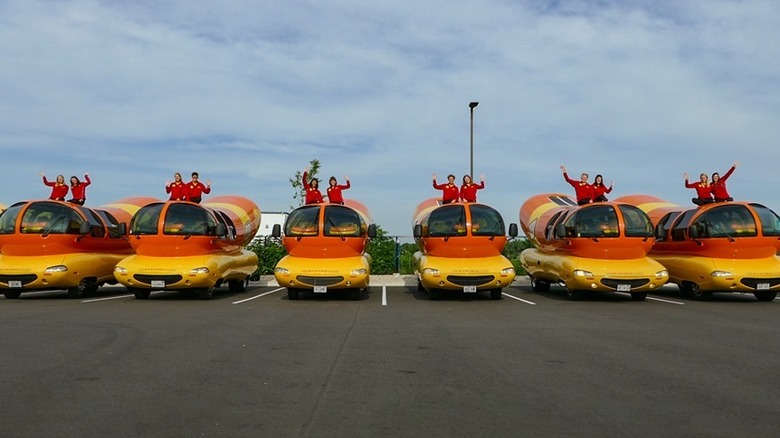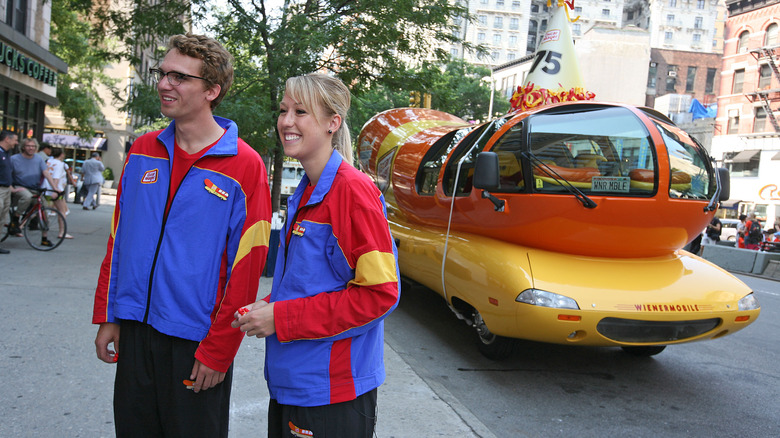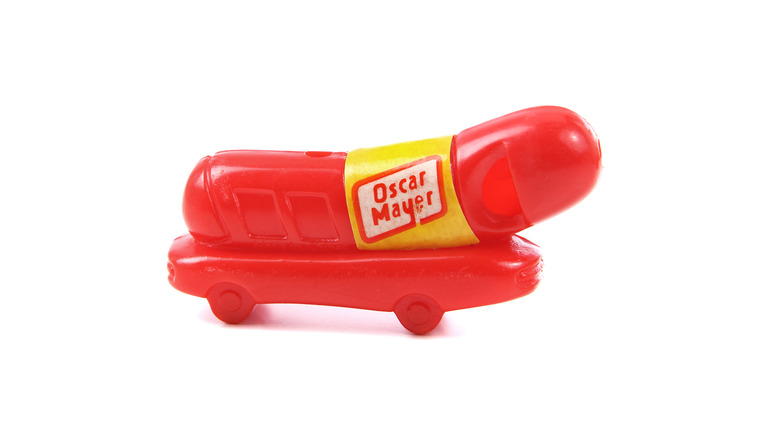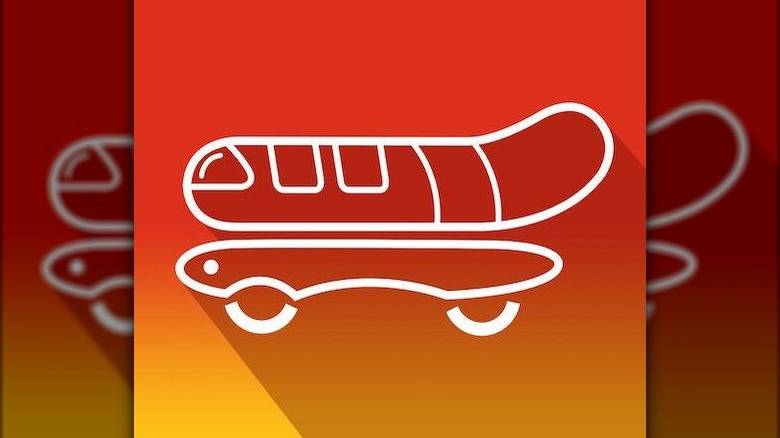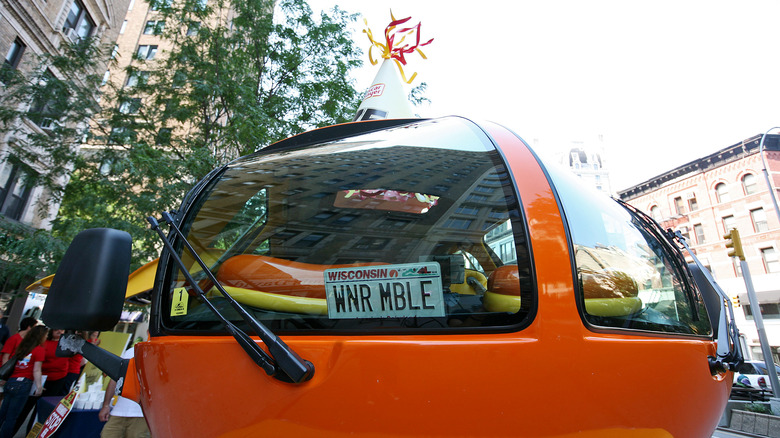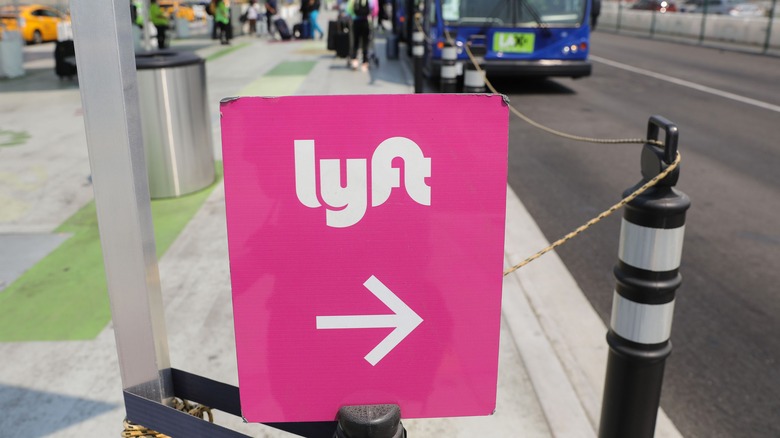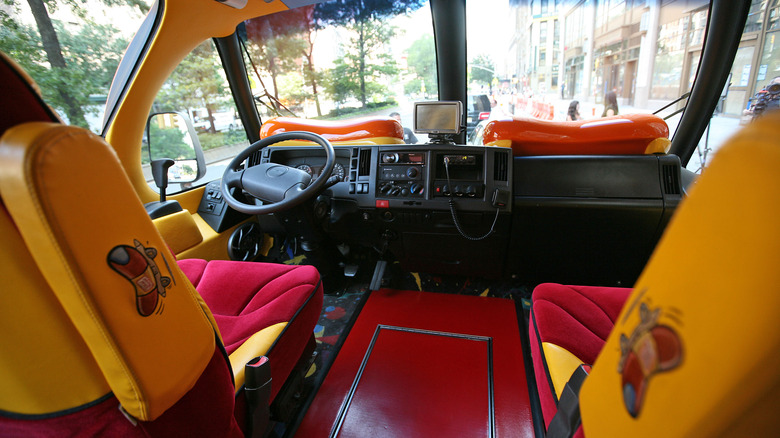Facts You Should Know About The Oscar Mayer Wienermobile
If you've been lucky enough to spot it, chances are, you'll never forget it. And how could you? It's not every day that you see a giant hot dog in a bun rolling down the highway.
You may be most familiar with the Oscar Mayer Wienermobile due to its frequent appearances in the brand's marketing campaigns, popping up in television commercials and on social media. However, if that's your only experience with the Oscar Mayer Wienermobile, you might assume the vehicle is a relatively new invention. It's extremely creative, after all, and it's not like motor vehicles have been around for much longer than a century or so. Or maybe you think there's only one Wienermobile that's only brought out of storage for special occasions and those TV commercials. However, none of this is the case at all. The Oscar Mayer Wienermobile boasts a rich and varied past, and there's a lot to learn about this little piece of Americana. Here are the facts you need to know.
The Oscar Mayer Wienermobile was first created in 1936
The Oscar Mayer Wienermobile is surprisingly old. It was created in 1936, and according to Oscar Mayer, the Wienermobile was not Oscar Mayer's idea (yes, the brand's namesake was a real guy). It actually came from Mayer's nephew, Carl. In 1936, Carl approached his uncle with the idea to create a giant hot dog that would act as a marketing tool for the brand throughout Chicago.
The very first Wienermobile rolled out not long after Carl received his go-ahead from Oscar. This first iteration was intended to ferry the brand's spokesperson to and fro while proudly advertising Oscar Mayer wieners throughout Chicago. It sported an open cockpit, which was enclosed with glass a few years later. However, the Wienermobile took a brief hiatus not even a decade after its inception, when World War II resulted in gas rationing that made driving the Wienermobile around the Windy City less than ideal. After the war was over, though, the Wienermobile returned to the streets, but it wasn't alone. This time, Oscar Mayer debuted five Wienermobiles, which marked the beginning of the Wienermobile fleet.
The Wienermobiles took a longer hiatus in the 1970s and 1980s
Following the end of World War II and the 1950s debut of the Wienermobile fleet, (all of which, by the way, sported newly added sound systems and sunroofs), the Wienermobiles enjoyed a long stint of advertising the Oscar Mayer brand not just around Chicago, as originally planned, but all around the country. The fleet continued to grow and evolve for the next two decades.
However, in 1977, the Wienermobiles were put on another hiatus, but this time it wasn't because of a world war. Instead, as Oscar Mayer explains, the brand retired the fleet and intended to do so for good, as it moved toward other forms of advertising. Then, in 1986, Oscar Mayer rolled out a singular Wienermobile for a special 50th anniversary party. The lone Wienermobile's appearance alone attracted significant attention — so much attention, in fact, that Oscar Mayer decided to relaunch its Wienermobiles, introducing six brand-new mobiles in 1988. The new Wienermobiles were a great improvement on the originals, with amenities like microwaves and fridges.
The Wienermobile has evolved over the years
As you might imagine, the Wienermobile of the 1930s looked different from the Wienermobiles of the 1980s, which looks different from the Wienermobile of today. Over the years, the vehicle has been produced by a range of automobile manufacturers and in a variety of styles.
According to Engine Builder Magazine, the General Body Company of Chicago created the original 1930s Wienermobile with its open design before outfitting the cockpit with glass so that the vehicle could be driven beyond Chicago and into the broader region. While you might not be all that familiar with the General Body Company of Chicago, you'll recognize one of the names that helped created the later, 1950s Wienermobiles: Dodge. Other designs ditched the Dodge chassis, or base frame, for a Jeep chassis and then a Chevrolet van chassis. Later on, in 1995, the Wienermobiles received an update that increased their size to 11 feet tall, 27 feet long, and 8 feet wide. However, today's fiberglass mobiles are based on a 2004 design that features a converted General Motors Chevrolet chassis and offers quite a few cool amenities and elements, including a hot dog-shaped dashboard, a gullwing door, carpeting, solar panels, and a removable roof.
Today there are six total Wienermobiles — but so much more
Today's Wienermobile fleet is made up of six trackable hot dog-shaped vehicles, according to the brand. However, while there are six classic-style Wienermobiles (or, at least, as classic as you can get over nearly a century of designing and redesigning), the Wienermobile family actually includes quite a few vehicles beyond the Wienermobiles alone.
As Oscar Mayer details, the brand celebrated its 125th anniversary in 2008 by introducing the Mini Wienermobile, created on a BMW Mini Cooper S chassis and clocking it at approximately half the size of the real deal. In 2011, on the original Oscar Mayer Wienermobile's 75th birthday, the brand launched a Wienermobile food truck. In 2015, Oscar Mayer added the Wiener Rover — a battery-powered, remote control vehicle one-seventh of the size of a normal Wienermobile. Then, in 2016, Oscar Mayer morphed the Wienermobile with an RV and debuted its Wienie-Bago. Most recently, in 2017, the Wienermobile family grew to include the WienerDrone and the WienerCycle, an unmanned drone and a tricycle, respectively.
Driving the Wienermobile is a serious job
Someone has to drive all these hot dog-shaped vehicles, right? But don't just assume that driving a Wienermobile is an easy job akin to delivering pizzas or driving for Uber Eats (although those jobs aren't exactly easy, despite the general assumption). Instead, Oscar Mayer considers its Wienermobile drivers as spokespeople, giving them the title of "hotdoggers." As a listing for the job explains, the one-year, full-time role requires much more than just driving the Wienermobiles around. Hired hotdoggers also act as brand ambassadors on radio and television, conduct press interviews, appear at events, manage public relations, and more, which is likely why the job requires a degree related to communications or marketing.
Even if you think you qualify based on the above criteria, though, the competition is steep. As one hotdogger told The New York Times, each year's application window receives thousands of applications vying for just 12 spots, which might inspire some applicants to go above and beyond. One successful hotdogger, when applying, sent the Kraft Heinz team a picnic box filled with artificial grass and a blanket, atop which she arranged a cover letter wrapped in recycled Kraft cheese packaging, a resume inside a relish bottle, and paper hotdogs with her face on them — and even after all that, she still had to go through an interview process.
Hotdoggers control the iconic Wiener Whistle
Perhaps you've heard of the Oscar Mayer Wiener Whistle, sometimes just called the weenie whistle, but unless you're over a certain age, you may not have actually ever seen one. According to Oscar Mayer, the Wiener Whistle was created in 1951 and started appearing in packs of hot dogs a few years later, kind of like a prize you'd find in a cereal box. However, this vintage toy isn't as easily obtained today. There's only one place you can find it: aboard the Wienermobile.
Hotdoggers driving the Wienermobile hand out a range of items to fans, from koozies to key chains, but the most popular item is the Wiener Whistle (via The New York Times). A little like a kazoo, the whistle is small and now shaped like a miniature Wienermobile, though the original Wiener Whistles were shaped like hot dogs. While you can no longer buy the original Wiener Whistles straight from the source, you can find vintage and antique novelty items dealers selling them on sites like eBay, where you can claim two Wiener Whistles for under $40 apiece.
The Wienermobile has its own app
There's an app for everything, so why not the Wienermobile? In 2014, Oscar Mayer announced the launch of the Wienermobile app on Google Play and the Apple App store, available for free. The app's purpose is threefold, per the brand. It helps users find the Wienermobile nearest them via a "Find the Wienermobile" function. It also includes a function that allows users to take a photo and then plop an image of the Wienermobile into said photo (like if you wanted to pretend the mobile was parked in your driveway). Lastly, there's a game in which users race a Wienermobile through obstacle courses. According to the experiential marketing senior manager at the time, the app provides answers to the biggest Wienermobile questions Oscar Mayer typically receives: Where is it, can I take a picture with it, and can I drive it? Fortunately, the answer is yes to all three.
You can track the Wienermobile anywhere, any time
There are six Wienermobiles and they tour the country all year long, so it's likely that there's a Wienermobile near you at any given time. However, if you don't want to download the Wienermobile app to find out where the nearest Wienermobile is, you can track all six online via the Oscar Mayer Wienermobile tracker.
Use the tracker and enter your street address, city, or state to find the mobiles' current locations. You can also check out the mobiles' upcoming schedules so you can plan your own around meeting up with one. The schedules are published two months in advance and then further updates are made to the schedules closer to appearance time, as specific addresses and times are finalized. You never know quite where you'll find a Wienermobile. The hotdoggers take the mobiles out to a variety of events and locations. You might spot them rolling down the street in your town's annual holiday parade or catch one parked in your favorite grocery store's lot.
Wienermobiles were briefly available on Lyft
If you think you'll never qualify to become a hotdogger, but you still have big dreams of making it inside that big rolling wiener one day, well, you might've already missed your chance. Oscar Mayer briefly partnered with Lyft to offer rideshare rides in the Wienermobile last year (via Motortrend). The offer was only available in select cities from August 25–27, 2021. But for a lucky few, hailing a ride in the Wienermobile was as easy as booking a Lyft XL ride and then crossing all your fingers and toes hoping you were one of the few app users to be surprised by the Wienermobile.
The special promotion took place in Atlanta, New York City, Chicago, and Los Angeles, and not only were the rides possibly some of the coolest Lyft rides ever, but they were also free. Unfortunately, Oscar Mayer and Lyft didn't repeat the promotion in August 2022, but we can only hope it comes back in the future.
Wienermobiles aren't always the safest vehicles on the road
Wienermobiles inarguably give off a family-friendly vibe, and they're sure to bring out the kid in anyone with a heart and a hankering for hot dogs. But that doesn't necessarily mean that Wienermobiles are always the safest vehicles you might encounter. The fleet has been in its fair share of traffic incidents.
In 2007, a Wienermobile was driving around with possibly stolen plates (via The New York Times). In 2009, a hotdogger drove into a driveway to turn around, but, when attempting to pull out and back onto the road, accidentally put the Wienermobile in the wrong gear and drove the giant hot dog through a Wisconsin home, per NBC News. In 2015, a Wienermobile slid off the road and hit a pole in Enola, Pennsylvania, according to the Associated Press. More recently, in 2020, a hotdogger was let off with a warning after driving too close to a stopped car on the side of the road (via the Associated Press). Case in point? While the Wienermobile looks friendly, you should still give it plenty of room on the street; it is, after all, a giant metal hot dog hurtling along the highway.
